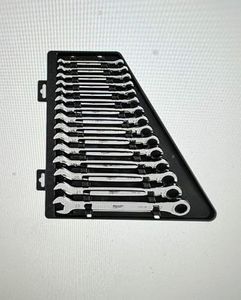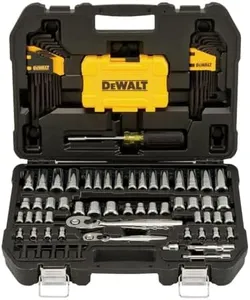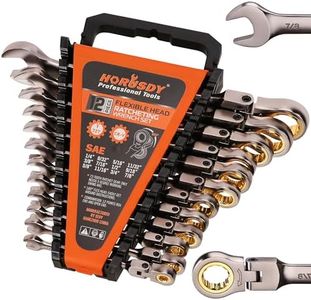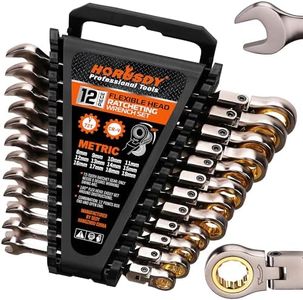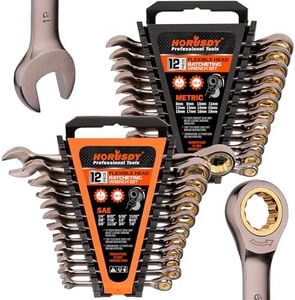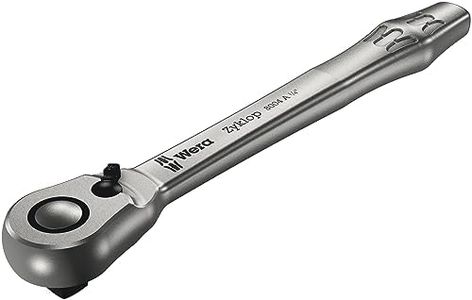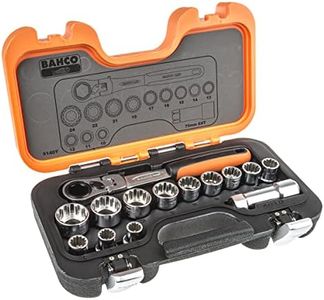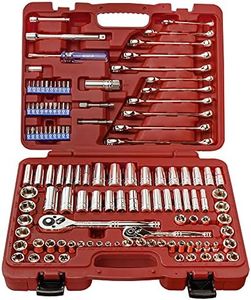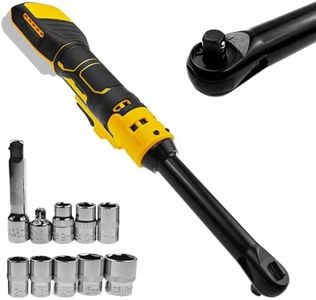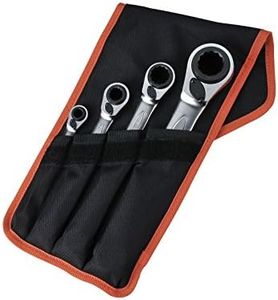We Use CookiesWe use cookies to enhance the security, performance,
functionality and for analytical and promotional activities. By continuing to browse this site you
are agreeing to our privacy policy
10 Best Ratchet Wrenches
From leading brands and best sellers available on the web.Buying Guide for the Best Ratchet Wrenches
Choosing the right ratchet wrench is all about matching the tool to the kind of jobs you plan to tackle. Whether you’re working on cars, bikes, appliances, or household projects, the right ratchet wrench can save you time and effort. Pay attention to features that impact comfort, durability, and versatility. Knowing which specifications matter will help you find a tool that feels good in your hand, fits the fasteners you encounter most, and holds up over time.Drive SizeDrive size refers to the square fitting on the ratchet head where you attach your sockets. Common sizes are 1/4-inch, 3/8-inch, and 1/2-inch. The drive size determines which sockets you can use and what kind of jobs the tool can handle. Smaller drive sizes (like 1/4-inch) are best for precision work and tight spaces, often used in electronics or bikes. Medium drive sizes like 3/8-inch are the most versatile, suitable for general automotive and household tasks. Larger sizes, like 1/2-inch, handle bigger bolts and heavy-duty applications, such as suspension parts on vehicles. Think about what fasteners you’ll be working with most often and select a drive size that fits the job.
Tooth CountThe tooth count refers to the number of teeth inside the ratcheting mechanism; it affects how far you need to swing the handle to engage the next click, known as 'arc swing.' A higher tooth count (such as 72 or 90 teeth) allows for a smaller swing, making it easier to use in tight or confined spaces. Lower tooth counts (like 24 or 36) require a bigger swing, but can be stronger and longer-lasting in harsh conditions. If you often work in areas with limited room to move the wrench handle, a higher tooth count is helpful. For heavy-duty or open-space jobs, tooth count is less critical.
LengthThe length of the ratchet wrench influences both leverage and access. Shorter wrenches are easier to maneuver in confined spaces but give you less leverage, so they're ideal for small fasteners or jobs where space is tight. Longer wrenches provide more leverage, making it easier to loosen stubborn bolts, but may be awkward in cramped quarters. Consider the kinds of spaces you’ll be working in and how much force you’ll need to apply when deciding on the ideal length.
Handle DesignHandle design varies in terms of comfort and grip. Some wrenches feature padded or ergonomically shaped handles, reducing hand fatigue during extended use. Others have simple straight or knurled handles for a sure grip, even with oily hands. If you will use the wrench for long periods, prioritize comfort and grip. If you're working mainly in a workshop or where you might get greasy, textured handles can be particularly helpful.
Material and FinishThe materials and finish used in ratchet construction affect durability, corrosion resistance, and ease of cleaning. Chrome vanadium steel with a polished chrome or matte finish is common, offering strength and rust resistance. Some wrenches have additional coatings or special treatments. A polished finish cleans up easily, while a matte or black-oxide finish may offer more grip. If you expect heavy use or exposure to moisture, prioritize wrenches made from robust metals with quality finishes.
Quick-Release MechanismSome ratchet wrenches include a quick-release button that makes it faster and easier to switch sockets, especially useful when your hands are greasy or when working overhead. This feature isn’t necessary for every user, but if efficiency and ease of use matter to you—especially in automotive work—it can be a real time-saver.
Reversing MechanismThe reversing mechanism lets you change the direction the wrench turns, enabling you to both tighten and loosen fasteners. Look for a model with an easily accessible and smooth-operating switch—for example, a thumb lever—so you can reverse direction without removing the wrench from the fastener. Frequent direction changes or tight spaces benefit from a convenient and reliable switch.
